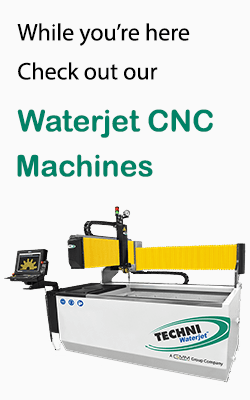Almost all industrial projects typically require the use of pressurized water in one way or the other. From cutting material to cleaning purposes , a high-velocity waterjet system finds its application in all metalworking, woodworking, mining, and other areas.
However, when you need to buy quality waterjet pump accessories, you might be confused by the number of choices available. Many manufacturers throw in fancy words just to make their equipment sound better.
In this article on water jet pumps, you will learn about different types of pumps and the things you should consider before buying one.
What are the Most Important Factors to Consider When Buying a Water Jet Pump?
There are certain things that you should consider before deciding which waterjet system pump you want to invest in. In fact, if you prioritize choices available based on these things, you will have an easy time deciding.
Some of the factors that influence waterjet pumps are:
Pump Size
Waterjet pump power is measured in horsepower (HP). Usually, you will find pumps of 150 HP, 100 HP, 75 HP, 50 HP, and 30 HP.
Many people confuse pump size with pump pressure, assuming that is a higher pressure in a 75 HP pump compared to a 50 HP pump. However, that is not the case.
The power rating of the waterjet machine system directly relates to the output capacity of the pump. Therefore, a 100 HP pump will be able to pump a larger volume of water, but not necessarily at a higher pressure.
An important thing to keep in mind if you need a bigger pump is the electrical requirements. A machine with more horsepower will require significantly more electricity and high-capacity electrical wiring.
Therefore, make sure that your workshop’s current wiring system can sustain the electrical requirement of any pump you buy. Contact manufacturers directly if you have any doubts.
Pressure
The pressure rating of a waterjet machine is mentioned alongside the pump’s power rating. It is measured in psi or bars.
You might think that the highest pressure pumps, typically, between 60,000 psi and 90,000 psi are the best choice. However, while these machine indeed have plenty of power, they also require more expensive maintenance and have a higher operating cost.
If you want to keep your operating cost low, it is best to get a pump between 40,000 psi and 50,000 psi. These require less maintenance compared to higher pressure pumps.
Dual Pressure Pumps
Techni Waterjet’s dual pressure pump systems provide the best cases of utilizing the power of a quality high-pressure pump and the low operating costs of a low-pressure pump.
This manufacturer’s machine comes with compatible waterjet controlling software. With the aid of the software, you can determine and adjust the garnet abrasive flow rate and the pressure of the pump based on the material to be cut.
The added benefit of reducing the high pressure comes when you cut brittle materials. When operating with ultra-high pressure, materials tend to break down. Therefore, to cut a material safely, reducing pressure through a dual pressure pump is best.
Maintenance Time and Maintenance Cost
Maintenance is a very important factor to consider when choosing waterjet pump systems. A regular maintenance visit from a qualified technician is essential to ensure a pump continues working optimally. But if it suffers downtime frequently, not only will it be expensive but you won’t be able to cut anything while maintenance is ongoing.
When choosing a high-pressure pump system, ensure it’s easily serviceable for maintenance. For instance, Techni Waterjet high pressure systems comes with an easy-access design and smarter controls to reduce the cost of maintenance.
Noise
Early designs of waterjet systems were slow machines that created plenty of noise. However, recent designs have improved significantly, not only in terms of a higher cutting speed but also having a lower noise level.
A modern waterjet machine comes with the option to cut the material underwater, which leads to reduced noise. However, such noise reduction isn’t beneficial if your pump has excessively noisy parts.
This is why Techni Waterjet’s Quantum range is designed to create negligible sound. With a noise level of 70 dB, you get a faster cutting speed and a quieter workspace.
Carbon Footprint
In recent years, everyone has moved to work processes and equipment that are more eco-friendly and leave a lower carbon footprint. It’s the same for high-pressure waterjet pump systems as well. All the common components such as gears, drives, rails, etc. have been designed to produce way less noise and a lower carbon footprint.
It is advisable to use a pump that does not waste utilities. Additionally, a pump with a low carbon footprint will also require fewer oil changes.
Power Availability
As mentioned previously, a larger sized pump will have higher electricity requirements. Before getting a pump, check the current electrical wiring of your shop to see if it can support the pump you want to purchase.
If your current electrical wiring system is not sufficient for your required pump, it can cause your pump to malfunction or the wires to burn out. Therefore, if your current setup is not up to the mark, upgrade the necessary parts of your electrical wiring before your install the pump.
The cost of installing new electrical power that supports ultra high-pressure pumps can be significant. Therefore, consider pump ability accordingly, along with focusing on the efficiency of pump design.
Techni Waterjet pumps are the best way in this regard. Even a 52,000 psi pump will consume electricity of just 15 KW, which is less than alternative options.
Operating Cost
The waterjet pump system that you set up should provide optimal performance for you while keeping the operating cost/hour feasible. Before you decide on which pump is most suitable for your needs, let’s examine how to determine operating costs.
Typically, these calculations can be complicated, so you can make use of Techni Waterjet’s Waterjet Manager to simplify the job. It is available for both Android and iOS.
If you want to calculate the cost manually, you need to take multiple factors into account, such as the cost of garnet abrasive, electricity, water and wear and tear of components. When talking about wear and tear, you will have to account for components like filters, seals, check valves, and other consumables.
Once you have listed all the cost items, you can determine the cost per hour on the basis of the cutting speed of your intended workpiece materials.
Cutting Speed
Professional workshops that handle many projects require a waterjet machine to cut at high speed. Therefore, they will prefer a pump that can provide an ultra-high water pressure.
For hobbyists or small-scale workshops where a high cutting rate is not a requirement, a smaller pump will suffice and cost less.
It is important to note that while a high-pressure pump has a higher cutting speed, the pressure is not relevant to the maximum cutting thickness. You can make adjustments to the maximum cutting thickness by adjusting the hours you spend on the cutting process.
Additional Factors
There are some other factors as well that can affect your decision when you are thinking about buying a waterjet pump system. These factors include:
Pump Starting Time: Some waterjet machines require some hours to start because they need to warm up while you wait. You cannot turn these machines off for short breaks. Others start instantly. Choose the pump that is ideal for how you work.
Simultaneous Running Capability: There are waterjet pump systems that can run multiple cutters at the same time. If you have multiple machines running at the same time, a pump system like this will probably have a lower cost/hour.
Spare Components Availability: You might be tempted to look for a high-end machine that comes with exotic features. However, it is very important to consider the availability of spare components, so make sure the pump you choose has ample spare components availability in the future.
Space Availability: Many people buy the most expensive machines only to realize they do not fit in their current workspace. Therefore, if you work in a limited space, make proper measurements before placing your order.
Choosing Between Crankshaft and Intensifier System
When it comes to different types of waterjet pump systems, there are two basic technologies. A waterjet pump machine is based either on a crankshaft system or an intensifier system. So what is the basic difference between the two?
In a crankshaft mechanism, mechanical movement is achieved by an assembly of cranks and crankpins. This mechanical movement creates pressure.
In an intensifier pump machine, the internal movement in the pump assembly is created by a hydraulic system, which generates the pressure.
Which One to Choose?
Choosing between the two technologies is not a straightforward choice since there are multiple factors to consider.
When you look at crankshaft systems, it’s a highly efficient machine which deliver most of the input power to the output. An intensifier system, on the other hand, is not very efficient. Its ability to transfer the input energy to output is somewhat limited as a lot of potential is wasted in the internal workings of the pump.
In contrast, crankshafts heat up quickly and require open-loop cooling. This leads to a lot of wastage. Intensifiers avoid this problem with a closed-loop heat exchanger, which leads to long-lasting parts such as valve seals.
Techni Waterjet Quantum pumps are the best of both worlds. They utilize the benefits of each of the two systems, while eliminating their cons. This is why even existing crankshaft and intensifier users are shifting to Techni Waterjet Quantum pumps.
Pump Horsepower
Let’s be clear about one important thing: pump horsepower does not mean how much horsepower is provided at the nozzle. This term refers to the power of the electric motor inside the pump.
Several processes go on inside a pump which lead wastage of energy. Therefore, at the nozzle, a significant fraction of the horsepower has been lost.
Even with constant pump horsepower, the nozzle horsepower can vary based on the type of pump you use – crankshaft or intensifier.
A crankshaft machine retains a higher percentage of pump horsepower, while an intensifier machine has higher losses.
Therefore, to avoid confusion, it is better to consider nozzle horsepower and nozzle size.
Nozzle Horsepower
The nozzle horsepower value refers to the power of the water at the nozzle. A nozzle with a higher horsepower value means faster cutting.
Nozzle Size
The nozzle affects the entire cutting operation, including the cut rate and cut quality. However, the nozzle consists of three components:
Jewel (Orifice) Diameter
The orifice or jewel diameter is where water under high pressure turns into a narrow cutting stream inside the nozzle.
All the pressure is behind this orifice, which significantly increases the water’s velocity while decreasing the width of the stream and focusing it.
A smaller jewel diameter allows less water to pass. Therefore, you can use lower horsepower features to maintain the flow.
Mixing Tube Diameter
Once water exits the jewel orifice, it enters the mixing tube. The diameter of this tube also affects the power rating of the pump.
Typically, a smaller mixing tube diameter provides the benefit of a high-velocity cutting stream with a better focus. This means a higher cutting speed, more preciseness, and smaller kerf width. The high pressure lowers the pump horsepower requirement.
However, always remember that a smaller mixing tube diameter also means more wear and tear, leading to more frequent nozzle changes.
Mixing Tube Length
With a longer mixing tube, you can focus the cutting stream better, leading to higher accuracy. Note that a short mixing tube will lead to more water spread, lower accuracy, and a higher kerf width.
Cutting Speed
It is a fact that greater pump horsepower creates a higher cutting speed. There are options that produce 100,000 psi for faster cutting. However, don’t be wowed by this apparent benefit, if you really don’t need it. You need to remember one thing – the maintenance factor, which can be expensive.
When using a very high horsepower pump, the wear and tear of all accessories increases significantly. This adds a lot of unwanted cost to the cutting system and induces frequent breakdowns.
As an alternative, the best way to increase the cutting speed without opting for ultra-high pressure pumps is to decrease the jewel diameter. When you increase the jewel diameter, even a 50,000 psi pump can work at the same cutting speed as a 100 psi pump with a larger jewel size.
Final thoughts on how to choose a waterjet pump
We understand that it can be difficult to find the best waterjet pump for your requirements. Several technical factors will affect your choice. This guide shows you how to prioritize your options based on the factors mentioned.
Most people looking for a waterjet pump nowadays opt for Techni Waterjet Quantum range of electric servo pump systems. These have been created after years of research, utilizing the top technologies available.
These pump systems are 60% more efficient and 6 times quieter than hydraulic intensifiers in cutting operations. Additionally, better pressure control results in a longer lifespan for parts, almost 3 times that of regular waterjet pump systems.





